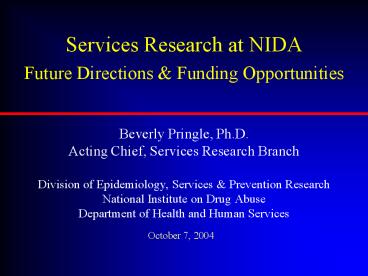Services Research at NIDA Future Directions - PowerPoint PPT Presentation
1 / 21
Title:
Services Research at NIDA Future Directions
Description:
Division of Epidemiology, Services & Prevention Research. National Institute on Drug Abuse ... PA-01-013 Economics of Drug Abuse Treatment and Prevention Services ... – PowerPoint PPT presentation
Number of Views:40
Avg rating:3.0/5.0
Title: Services Research at NIDA Future Directions
1
Services Research at NIDA Future Directions
Funding Opportunities
- Beverly Pringle, Ph.D.
- Acting Chief, Services Research Branch
- Division of Epidemiology, Services Prevention
Research - National Institute on Drug Abuse
- Department of Health and Human Services
October 7, 2004
2
SRB Staff
- Bill Cartwright, Ph.D. Economics
- Redonna Chandler, Ph.D. Criminal Justice, DSM
- Jerry Flanzer, Ph.D. Primary Care, Homelessness
- Bennett Fletcher, Ph.D. CJ-DATS
- Tom Hilton, Ph.D. Organization .Management
- Dionne Jones, Ph.D. Gender Issues, Rural Care
- Noble Jones, M.A. Adolescents, Bioethics
3
Services Research Related Program
Announcements
- PA-01-097 Drug Abuse Health Services Research
- PA-01-013 Economics of Drug Abuse Treatment and
Prevention Services - PA-03-011 Services Research in the National Drug
Abuse Clinical Trials Network - PA-02-164 Economic Evaluation of Drug Abuse
Treatment and Prevention Services for HIV/AIDS - PA-04-153 Health Disparities Among Minority and
Underserved Women - PA-04-061 Research on Rural Mental Health and
Drug Abuse Disorders - PA-03-139 Women, Gender Differences and Drug
Abuse
4
NIDAs Services Research Mission
- Multidisciplinary field of scientific inquiry
that
Examines how
Affect
Social Factors
Access Utilization
Financing
Quality of Care
Organization
Cost of Care
Management
Technologies
Outcomes Public health well being
Behaviors
For individuals, families, organizations
institutions, and communities populations
5
SRB 2005 Priorities
Research Domains Organization
management Economics Technology
transfer Research Contexts Chronic relapsing
nature of substance abuse Co-occurring
conditions, including HIV/AIDS Alternative
treatment settings Research Methods Rigor,
appropriate designs Researchers New
investigators Research Environments Transdiscipli
nary research teams
6
Overarching Theme Maximize Return on Investment
- Conduct secondary data analyses.
- Embed questions, measures, novel topics within
existing research (e.g., CTN). - Build on studies in other institutes.
- Examine existing programs (e.g., SAMHSA, State
Initiatives).
7
Services Research in the CTN
- Economic Evaluations in the CTN Methods
Applications (Sindelar) - CTN Membership Adoption of Innovative Treatment
Practices (Roman) - Organizational Processes in Treatment Programs
(Arfken) - Cost-Effectiveness Analysis in the CTN
Buprenorphine/Naloxone Treatment for Opioid
Addicted Youth (Polsky)
8
1 Research Domains
- Organization Management
- Economics
http//www.drugabuse.gov/about/organization/nacda/
HSRReport.pdf
9
Economics Organization/Management
Typical prevention and treatment practitioner
questions about a new intervention What
will it cost? What is the benefit that can
be expected? How will this fit into my
organization?
10
Buprenorphine for treatment of concurrent opiate
and cocaine dependence (Montoya, 2004)
11
Possible Economics Questions For the
Buprenorphine Trial
- What is the cost of treatment (i.e. without
research costs)? - Is the daily16-mg dose more cost-effective than
the daily 8-mg dose for opiate reduction? What
about for cocaine reduction?
12
1 Research Domains
- Technology Transfer to measurably impact
public health prevention and treatment outcomes
http//nihroadmap.nih.gov
13
Evidence of efficacy is necessary but
insufficient
Client Access and Engagement
Organization Structure and Climate
Tx Efficacy
External Environment (stigma, financing)
Provider knowledge and behavior
14
Research DomainsTechnology Transfer
- DA-05-002
- Enhancing State Capacity
- to Foster Adoption of
- Science-Based Practices
- FY05 1.35m RFA with SAMHSA
- 18 applications
- to be reviewed December 2004
15
2 Research Contexts
- Chronic relapsing nature or substance abuse
- Co-occurring conditions, including new issues in
the emerging HIV/AIDS - drug abuse nexus - Many treatment settings
16
Co-occurring Conditions Alternate Treatment
Settings
DA-04-006 Prevention and Treatment of Drug Abuse
in Primary Care Settings 3.6m RFA with SAMHSA
AHRQ 7 grants awarded DA-04-015 HIV/AIDS
Among Drug Users in Criminal Justice
Settings 1.5m RFA 6 grants awarded
17
3 Research Methods
- Attention to fit between research questions and
study design - Randomized trials where appropriate feasible
- Nonexperimental methods that permit greater
causal inference
18
4 Researchers Research Environments
- Develop transdisciplinary research teams to
better elucidate this chronic condition, its
prevention, and treatment.
Develop new services research investigators.
19
Division of Epidemiology, Services Prevention
Research
- Providing a foundation for NIDAs public health
mission
20
DESPR Organization
OFFICE OF THE DIRECTOR
21
Priority Areas for NIDA
- Prevention Research (Children/Adolescents)
- Genetics
- Development
- Environment
- Co-morbidity
- Treatment Interventions
- New Targets New Strategies
- HIV/AIDS Research
- Criminal Justice, Health Disparities,
Prescription Drug Abuse - Collaborations with Other NIH Institutes and
Other Federal, State and Local Partners































